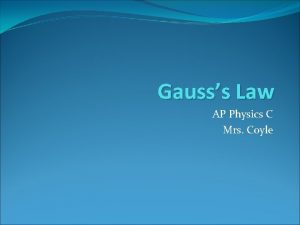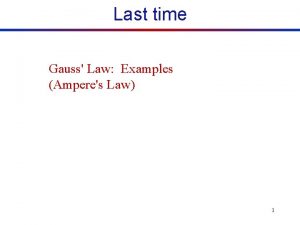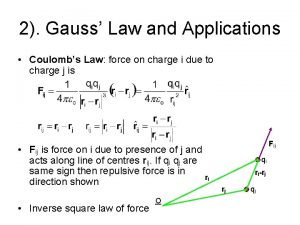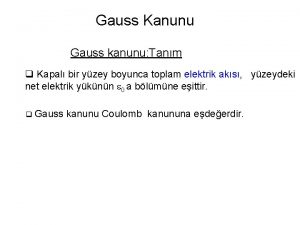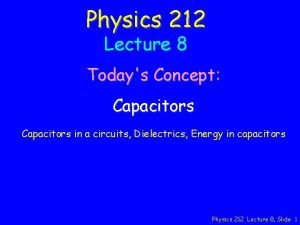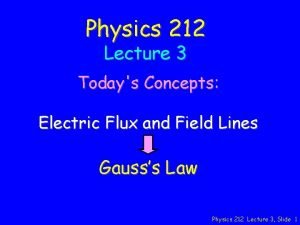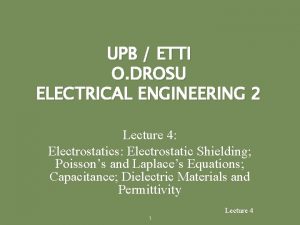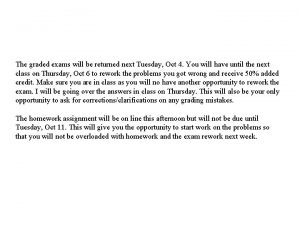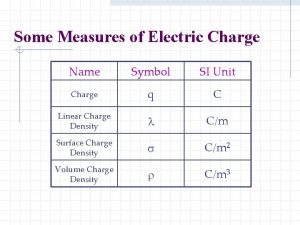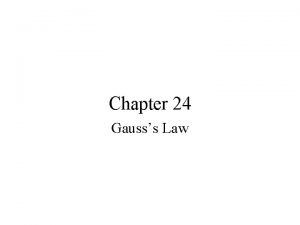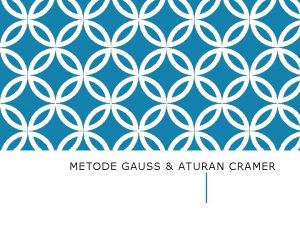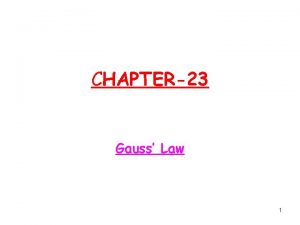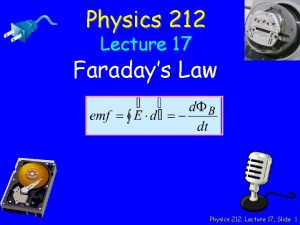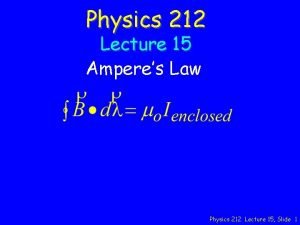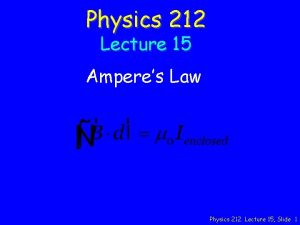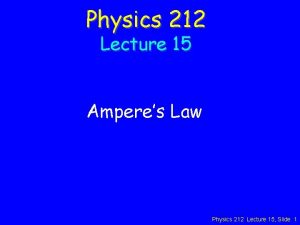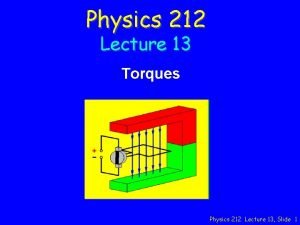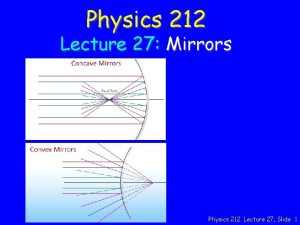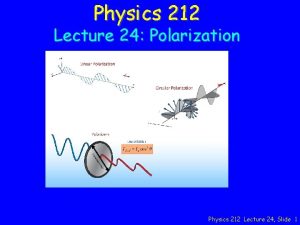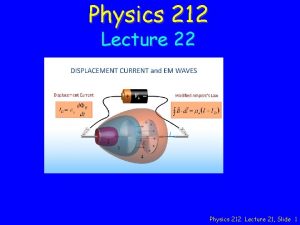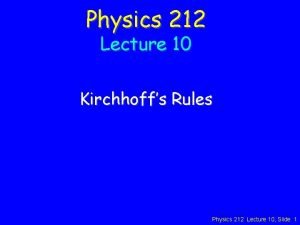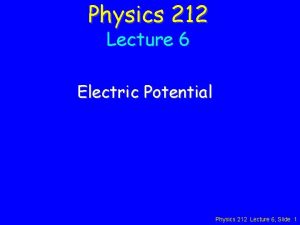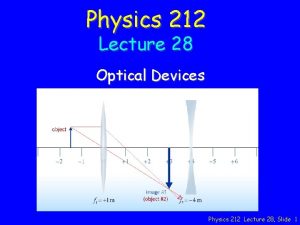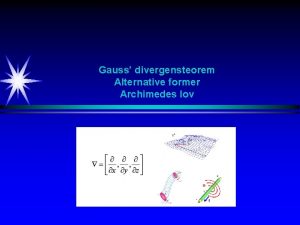Physics 212 Lecture 4 Gauss Law Physics 212

















- Slides: 17

Physics 212 Lecture 4 Gauss’ Law Physics 212 Lecture 4, Slide 1

Gauss’ Law In general, the integral to calculate flux is difficult. But in cases with symmetry (spheres, cylinders, etc. ) we can find a closed surface where, is constant everywhere on the surface. For such cases, 19 Physics 212 Lecture 4, Slide 2

Example E field from an infinite line of charge with charge density r L Choose cylinder of radius r, length L, centered on the line of charge. By symmetry, E field points radially outward ( for positive ) and so

Examples with Symmetry Spherical 21 Cylindrical Planar Physics 212 Lecture 4, Slide 4

Checkpoint 4 In which case is E at point P the biggest? A) A B) B C) the same Recall that for an infinite plane with charge density (Coul/m 2), E = /2 0 27 Physics 212 Lecture 4, Slide 5

Superposition ! NET + Case A 34 + - + Case B Physics 212 Lecture 4, Slide 6

Checkpoint 1 The E field from a charged cube is not constant on any of these surfaces. Gauss’s law is true, but it does not help us to calculate E for this particular problem. (D) The field cannot be calculated using Gauss’ Law (E) None of the above How to calculate the field? Go back and find E by superposition. Add the contributions to E from each infinitesimal charge dq in the cube: 23 Physics 212 Lecture 4, Slide 7

Conductors = charges free to move Claim: E = 0 inside any conductor at equilibrium Why ? Charges in a conductor will move if E 0. They redistribute themselves until E = 0 and everything comes to equlibrium. Claim: Any excess charge in a conductor is on the surface (in equilibrium). Why? Take Gaussian surface (dashes) to be just inside conductor surface. E = 0 everywhere inside conductor. Use Gauss’ Law: 06 Physics 212 Lecture 4, Slide 8

E = 0 inside conductors Charges reside on surfaces of conductors. Induced Charges Begin with a neutral conductor: Q=0 No charge inside or on the surface Now bring a positive charge +Q near the conductor. This induces (-) charge on one end and (+) charge on the other. The total charge on the conductor is still zero. The induced charge is on the surface of the conductor. 09 + + + - +Q Physics 212 Lecture 4, Slide 9

Charge in Cavity of Conductor A particle with charge +Q is placed in the center of an uncharged conducting hollow sphere. How much charge will be induced on the inner and outer surfaces of the sphere? A) inner = –Q, outer = +Q B) inner = –Q/2 , outer = +Q/2 C) inner = 0, outer = 0 Qouter Q D) inner = +Q/2, outer = -Q/2 E) inner = +Q, outer = -Q Qinner 10 Physics 212 Lecture 4, Slide 10

Checkpoint 3 26 Physics 212 Lecture 4, Slide 11

Checkpoint 3 What is direction of field OUTSIDE the red sphere? Using a Gaussian surface that enclosed both conducting spheres, the net enclosed charge will be zero. Therefore, the field outside will be zero. 29 Physics 212 Lecture 4, Slide 12

Checkpoint 2 31 Physics 212 Lecture 4, Slide 13

Calculation y r 2 neutral conductor +3 Q r 1 x Point charge +3 Q at center of neutral conducting shell of inner radius r 1 and outer radius r 2. What is E everywhere? 36 A Magnitude of E is function of r. A Direction of E is along B Magnitude of E is function of (r-r 1). B Direction of E is along C Magnitude of E is function of (r-r 2). C Direction of E is along D None of the above Physics 212 Lecture 4, Slide 14

Calculation y r 2 neutral conductor +3 Q E is a function of r. Direction of along. r 1 x r < r 1 40 is Use Gauss’ Law with a spherical surface Centered on the origin to determine E(r). r 1 < r 2 r > r 2 A A B B C C Physics 212 Lecture 4, Slide 15

r 2 neutral conductor +3 Q r < r 1 r > r 2 r 1 < r 2 What is the induced surface charge density at r 1 ? A Gauss’ Law: r 2 B C 44 +3 Q r 1 Similarly: Physics 212 Lecture 4, Slide 16

y r 2 Now suppose we give the conductor a charge of -Q a) What is E everywhere? b) What are charge distributions at r 1 and r 2? -Q conductor +3 Q r 1 + + r 2 x + + + +3 Q + + + r < r 1 46 r > r 2 A A B B C C r 1 + -3 Q + + +2 Q + + r 1 < r 2 Physics 212 Lecture 4, Slide 17
 Physics gauss law
Physics gauss law Gauss law physics classroom
Gauss law physics classroom Coyle electric
Coyle electric Are we getting
Are we getting Gauss's law in integral form
Gauss's law in integral form Coulombs law
Coulombs law Gauss elimination method
Gauss elimination method Küp elektrik akısı
Küp elektrik akısı Physics 212 gradebook
Physics 212 gradebook Physics 212 gradebook
Physics 212 gradebook 01:640:244 lecture notes - lecture 15: plat, idah, farad
01:640:244 lecture notes - lecture 15: plat, idah, farad Newton's first law and second law and third law
Newton's first law and second law and third law Newton's first law and second law and third law
Newton's first law and second law and third law Boyle's law charles law avogadro's law
Boyle's law charles law avogadro's law Constant in avogadro's law
Constant in avogadro's law Differential form of gauss law
Differential form of gauss law Gauss law in dielectrics
Gauss law in dielectrics What is the symbol of surface charge density called
What is the symbol of surface charge density called


